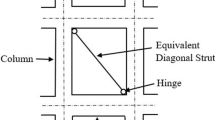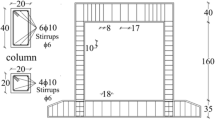Abstract
Substructure hybrid simulation test (SHST) is a novel seismic experimental method for analyzing structures, which usually divides the global structure into two components: the experimental substructure and the numerical substructure. An SHST system based on the OpenFresco platform was established. To ensure the high accuracy of the numerical substructure in SHST, a finite element model that corresponded to a quasi-static experimental investigation on high-strength steel composite K-shaped eccentrically braced frame (K-HSS-EBF) was established and analyzed using OpenSees. A three-story and five-span spatial K-HSS-EBF was used as the prototype and the three-story steel frame with a K-eccentric brace on the left second span was taken as the experimental substructure. The remaining four-span was modeled as a numerical substructure in OpenSees. SHST was performed with a half-scale hybrid simulation model. According to the test results, the displacement loading precision of the experimental substructure was analyzed. In addition, the shear link rotations of the experimental and numerical substructures were compared. The time curve of the displacement and the base shear of the hybrid simulation model were also compared with the simulation results of the global numerical model. The results revealed that the seismic response characteristics of the K-HSS-EBF were successfully recaptured using the numerical substructure model established in OpenSees and the spatial SHST system based on OpenFresco.




















Similar content being viewed by others
References
Carrion JE, Spencer BF Jr (2008) Real-time hybrid testing using model-based delay compensation. Smart Struct Syst 4(6):809–828
Chae Y, Ricles JM, Sause R (2013) Large-scale experimental studies of structural control algorithms for structures with magneto-rheological dampers using real-time hybrid simulation. J Struct Eng 139:1215–1226
Chae Y, Park MC, Kim Y, Park YS (2017) Experimental study on the rate-dependency of reinforced concrete structures using slow and real-time hybrid simulations. Eng Struct 132:648–658
Chen C, Ricles JM (2012a) Analysis of implicit HHT-α integration algorithm for real-time hybrid simulation. Earthq Eng Struct Dyn 41(5):1021–1041
Chen C, Ricles JM (2012b) Large-scale real-time hybrid simulation involving multiple experimental substructures and adaptive actuator delay compensation. Earthq Eng Struct Dyn 41(3):549–569
Chen Z, Yan X, Wang H, Zhu X, Spencer BF (2018) Substructure hybrid simulation boundary technique based on beam/column inflection points. Sustainability 10(8):2655
Darby AP, Blakeborough A, Williams MS (1999) Real-time substructure tests using hydraulic actuator. J Eng Mech 125(10):1133–1139
Dermitzakis SN, Mahin SA (1985) Development of substructuring techniques for on-line computer controlled seismic performance testing. Research Report No. UCB/EERC-85/04, Earthquake Engineering Research Center, Berkeley, CA
Du K, Sun JJ, Xu WX (2012) The division of element, section and fiber in fiber model. J Earthq Eng Eng Vib 32(5):39–46 (in Chinese)
Fermandois GA, Spencer BF (2017) Model-based framework for multi-axial real-time hybrid simulation testing. Earthq Eng Eng Vib 16(4):671–691
GB 50011-2010 (2016 edition) (2016) Code for seismic design of buildings. China Architecture and Building Press, Beijing
Hashemi MJ, Mosqueda G (2014) Innovative substructuring technique for hybrid simulation of multistory buildings through collapse. Earthq Eng Struct Dyn 43(14):2059–2074
Hashemi MJ, Al-Ogaidi Y, Al-Mahaidi R, Kalfat R, Wilson JL (2016) Application of hybrid simulation for collapse assessment of post-earthquake CFRP-repaired RC columns. J Struct Eng 143(1):04016149
Hayati S, Song W (2017) An optimal discrete-time feedforward compensator for real-time hybrid simulation. Smart Struct Syst 20(4):483–498
Karavasilis T, Ricles JM, Sause R, Chen C (2011) Experimental evaluation of the seismic performance of steel MRFs with compressed elastomer dampers using large-scale real-time hybrid simulation. Eng Struct 33(6):1859–1869
Khan MA, Jiang L, Cashell KA, Usmani A (2018) Analysis of restrained composite beams exposed to fire using a hybrid simulation approach. Eng Struct 172:956–966
Li S, Liu YH, Tian JB (2018a) Experimental and analytical study of eccentrically braced frames combined with high-strength steel. Int J Steel Struct 18:528–553
Li TF, Sui Y, Su MZ, Zhang H, Gao XY (2018b) Study on real time hybrid simulation test of an eccentrically braced frame as test substructure. J Hunan Univ: Nat Sci 45(11):46–53 (in Chinese)
Maikol Del Carpio R, Hashemi MJ, Mosqueda G (2017) Evaluation of integration methods for hybrid simulation of complex structural systems through collapse. Earthq Eng Eng Vib 16(4):745–759
Mazzoni S, McKenna F, Scott MH, Fenves GL (2009) Open system for earthquake engineering simulation user command-language manual—OpenSees version 2.0. Pacific Earthquake Engineering Research Center (PEER), University of California, Berkeley, CA
Menegotto M, Pinto E (1973) Method of analysis for cyclically loaded RC plane frames including changes in geometry and non-elastic behavior of elements under combined normal force and bending. IABSE symposium on resistance and ultimate deformability of structures acted on by well defined repeated loads, Lisbon, pp 15–22
Mohagheghian K, Mohammadi RK (2017) Comparison of online model updating methods in pseudo-dynamic hybrid simulations of TADAS frames. Bull Earthq Eng 15(10):4453–4474
Nakashima M, Kato H, Takaoka E (1992) Development of real-time pseudodynamic testing. Earthq Eng Struct Dyn 21(1):79–92
Neild SA, Stoten DP, Drury D, Wagg DJ (2005) Control issues relating to real-time substructuring experiments using a shaking table. Earthq Eng Struct Dyn 34(9):1171–1192
Ou G, Dyke SJ, Prakash A (2017) Real time hybrid simulation with online model updating: an analysis of accuracy. Mech Syst Signal Process 84:223–240
Özhendekci D, Özhendekci N (2008) Effects of the frame geometry on the weight and inelastic behaviour of eccentrically braced chevron steel frames. J Constr Steel Res 64(3):326–343
Pan P, Tomofuji H, Wang T, Nakashima M, Ohsaki M, Mosalam KM (2006) Development of peer-to-peer (P2P) internet online hybrid test system. Earthq Eng Struct Dyn 35(7):867–890
Schellenberg A, Kim HK, Takahashi Y, Fenves GL, Mahin SA (2009) OpenFresco Command Language Manual. The Regents of the University of California, CA, pp 38–39
Spencer BF, Elnashai A, Kuchma D, Kim S, Holub C, Nakataet N (2006) Multi-site soil-structure-foundation interaction test (MISST). University of Illinois at Urbana-Champaign, Urbana
Stojadinovic B, Mosqueda G, Mahin SA (2006) Event-driven control system for geographically distributed hybrid simulation. J Struct Eng 132(1):68–77
Tian XH, Su MZ, Lian M, Wang F, Li S (2018) Seismic behavior of K-shaped eccentrically braced frames with high-strength steel: shaking table testing and FEM analysis. J Constr Steel Res 143:250–263
Wang T, Mosqueda G, Jacobsen A, Cortes-Delgado M (2012) Performance evaluation of a distributed hybrid test framework to reproduce the collapse behavior of a structure. Earthq Eng Struct Dyn 41(2):295–313
Wu B, Wang Z, Bursi O (2013) Actuator dynamics compensation based on upper bound delay for real-time hybrid simulation. Earthq Eng Struct Dyn 42(12):1749–1765
Wu B, Chen Y, Xu G, Mei Z, Pan T, Zeng C (2016) Hybrid simulation of steel frame structures with sectional model updating. Earthq Eng Struct Dyn 45(8):1251–1269
Xiao Y, Guo YR, Zhu PS, Kunnathd S, Martinb R (2012) Networked pseudodynamic testing of bridge pier and precast pile foundation. Eng Struct 38:32–41
Yang G, Wu B, Ou G, Wang Z, Dyke S (2017) Hytest: platform for structural hybrid simulations with finite element model updating. Adv Eng Softw 112:200–210
Zhu F, Wang JT, Jin F, Gui Y (2016) Comparison of explicit integration algorithms for real-time hybrid simulation. Bull Earthq Eng 14(1):89–114
Acknowledgements
The authors are grateful for the financial support from the National Natural Science Foundation of China (Grant No. 51178382).
Author information
Authors and Affiliations
Corresponding author
Additional information
Publisher's Note
Springer Nature remains neutral with regard to jurisdictional claims in published maps and institutional affiliations.
Rights and permissions
About this article
Cite this article
Li, T., Su, M. & Sui, Y. Numerical modeling of high-strength steel composite K-eccentrically braced frames and spatial substructure hybrid simulation tests. Bull Earthquake Eng 17, 6239–6263 (2019). https://doi.org/10.1007/s10518-019-00720-2
Received:
Accepted:
Published:
Issue Date:
DOI: https://doi.org/10.1007/s10518-019-00720-2




